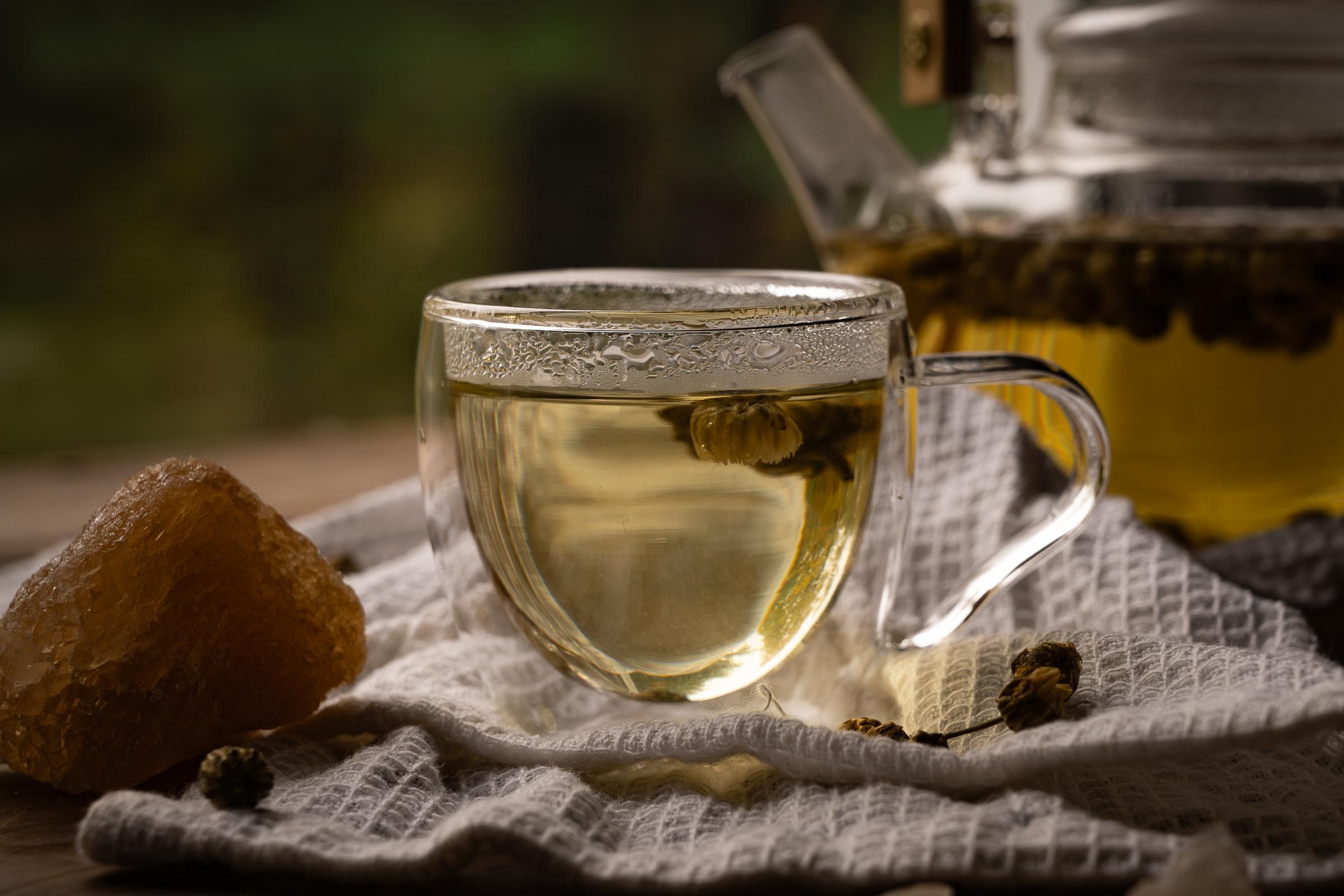Some of my earliest memories involve sitting at my grandmother’s kitchen table, watching her prepare chrysanthemum tea. I’d swing my legs from the chair, too short to reach the floor, fascinated by the way those dried flowers would bloom again when hot water hit them, turning clear water into liquid gold.
“Just flowers, water, and sugar,” she’d tell me in her accented English, pouring the tea into small cups. “That’s all you need. Simple is best.”
I’ve been drinking chrysanthemum tea since I was a kid, and I’m still drinking it now. What started as something my grandmother made for me on hot summer days or when I’d spent too long doing homework has become a daily ritual I can’t imagine living without. And the recipe? It’s exactly the same as it was back then. Three ingredients. Nothing more, nothing less.
Let me share my grandmother’s recipe with you—the one she learned from her grandmother, who learned it from hers. Centuries of wisdom, distilled down to three simple ingredients.
What My Grandmother Taught Me About Chrysanthemum Tea
My grandmother made chrysanthemum tea like most people make coffee—it was just part of her daily routine. Hot summer days? Chrysanthemum tea. Someone in the family had tired eyes from studying? Chrysanthemum tea. After a heavy meal? Chrysanthemum tea. Guests coming over? You guessed it—chrysanthemum tea.
Growing up, I took it for granted. This was just what we drank. It wasn’t until I got older and started making it for friends that I realized not everyone grew up with this. People would take a sip and ask, “What is this? It’s amazing!” And I’d have to explain that it was just something my grandmother made, something completely ordinary in my childhood home but apparently exotic to everyone else.
The tea is made from dried chrysanthemum flowers (菊花茶, or “ju hua cha”). My grandmother always kept a big bag of them in her pantry, tucked between the dried mushrooms and the rice. The flowers she used were the small yellow ones, though she’d sometimes get the white variety too. They looked almost papery when dried, but the moment hot water touched them, they’d come alive again.
The Only Three Ingredients You Need
This is my grandmother’s recipe, exactly as she made it for me as a child and exactly as I make it now:
- Dried chrysanthemum flowers: 6-8 flowers per cup (my grandmother literally counted them out)
- Water: She always used filtered water, said tap water made it taste wrong
- Rock sugar: 1-2 small pieces per cup, the amber-colored crystal kind
That’s it. Three ingredients. My grandmother would shake her head at the complicated recipes she’d see in magazines. “Why make simple things difficult?” she’d say. And she was right.
About My Grandmother’s Ingredients
The Flowers: My grandmother bought hers from the Asian grocery store in big plastic bags. She’d open the bag and smell them first—if they didn’t smell sweet and pleasant, she wouldn’t buy them. “Old flowers, no good,” she’d tell me. She taught me to look for flowers that were still relatively intact, not completely crumbled to dust.
The Water: She was particular about water. Always filtered, never straight from the tap. She said the chlorine would ruin the delicate flavor. I didn’t really understand as a kid, but now that I make it myself, I get it. The tea tastes noticeably different with filtered water.
Rock Sugar: This was non-negotiable in my grandmother’s kitchen. She kept a jar of rock sugar specifically for tea—those irregular, crystalline chunks that looked like amber gems. She’d never use regular white sugar for chrysanthemum tea. “Wrong taste,” she’d insist. “Rock sugar is correct way.” And honestly, she was right about that too.
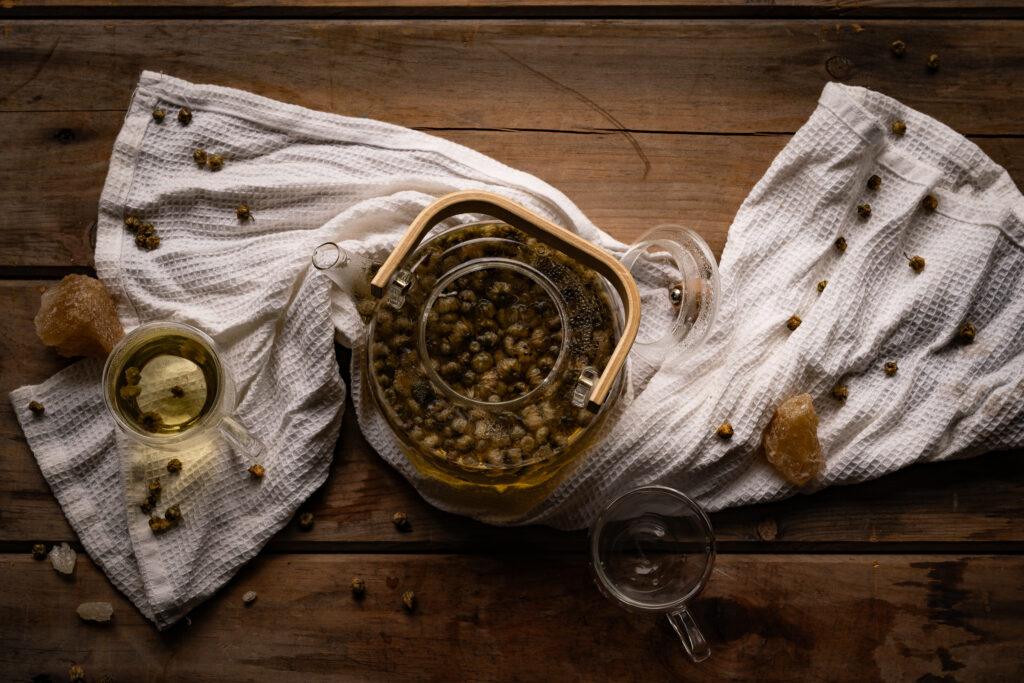
How My Grandmother Made It (And How I Make It Now)
Watching my grandmother make chrysanthemum tea was like watching a small ceremony. She had her way of doing things, and it never changed. I make it the exact same way now.
Step 1: Rinse the Flowers
My grandmother always rinsed the flowers first. “Flowers been traveling, need wash,” she’d say. She’d put them in a small strainer, run hot water over them quickly, swirl them around, and dump the water out. The whole thing took maybe ten seconds.
I do this same step now. It’s one of those things that seemed unnecessary when I was younger, but now I understand. Those flowers have been dried, packaged, shipped—a quick rinse just makes sense.
Step 2: Count Your Flowers
This was the part I always got to help with as a kid. My grandmother would have me count out the flowers—six to eight per cup, depending on how strong we wanted it. On really hot days, she’d use more. “Need stronger tea when hot outside,” she’d explain.
For a single cup: 6-8 flowers For her teapot (about 4 cups): 20-25 flowers
She never measured by volume or weight. Always by counting individual flowers. I still do it this way. It feels more connected to her somehow.
Step 3: The Water Temperature
Here’s something my grandmother was really particular about: the water couldn’t be boiling. She’d heat water until it boiled, then turn off the heat and wait a minute before pouring it over the flowers.
“Boiling water too hot, kill the flower taste,” she’d say. “Need hot water, not crazy hot water.” At the time, I thought she was just being fussy. Now I know she was completely right—water that’s too hot makes the tea bitter.
The ideal temperature is just below boiling, around 200°F if you want to be precise, but my grandmother never used a thermometer. She just knew. I’ve learned to do it her way: boil the water, then wait about a minute. That’s it.
Step 4: Pour and Watch
This was my favorite part as a kid, and honestly, it still is. My grandmother would slowly pour the hot water over the flowers, and we’d watch them come alive. They’d start to unfurl and float, and the water would gradually turn this beautiful golden color.
“See? Flowers wake up,” she’d say, smiling at my wonder every single time.
She’d let it steep for about 4-5 minutes. “Too short, no flavor. Too long, taste bitter,” she taught me. Four minutes was her sweet spot, and it’s become mine too.
Step 5: Add the Rock Sugar
While the tea was still hot, my grandmother would drop in one or two pieces of rock sugar. She’d usually start with one piece, let it dissolve, then taste. If it needed more sweetness, she’d add another piece.
“Chrysanthemum already sweet,” she’d remind me. “Sugar just help a little bit.”
She taught me to stir gently, or just let the sugar dissolve on its own. There was no rush. Watching the rock sugar slowly disappear into the golden tea was part of the ritual.
Step 6: Enjoy It Her Way
My grandmother would serve the tea in small cups or glasses, never big mugs. “Small cup, drink slow, enjoy more,” she’d say. On hot days, she’d let it cool completely and serve it over ice in tall glasses. On cold days, we’d drink it steaming hot, holding the warm cups with both hands.
That’s exactly how I drink it now. The method hasn’t changed since I was a kid sitting at her kitchen table.
The Cold Version My Grandmother Made in Summer
Summer at my grandmother’s house meant big pitchers of iced chrysanthemum tea in the refrigerator at all times. She’d make a huge batch in the morning, and we’d drink it throughout the day.
Her method was simple. She’d use a large pot, add about 30-40 flowers and 4-5 pieces of rock sugar, pour in hot water, let it steep for 5 minutes, then let the whole thing cool down. Once it was room temperature, into the fridge it went.
I remember coming inside from playing, sweaty and hot, and my grandmother would pour me a tall glass of cold chrysanthemum tea. It was more refreshing than any soda or juice. I didn’t appreciate it then, but I do now. That cold chrysanthemum tea is still my go-to drink on hot summer days.
She’d make a fresh batch every 2-3 days. “No keep too long, taste change,” she’d warn. I follow the same rule—big batch on Sunday, drink it through Wednesday, make fresh batch again.
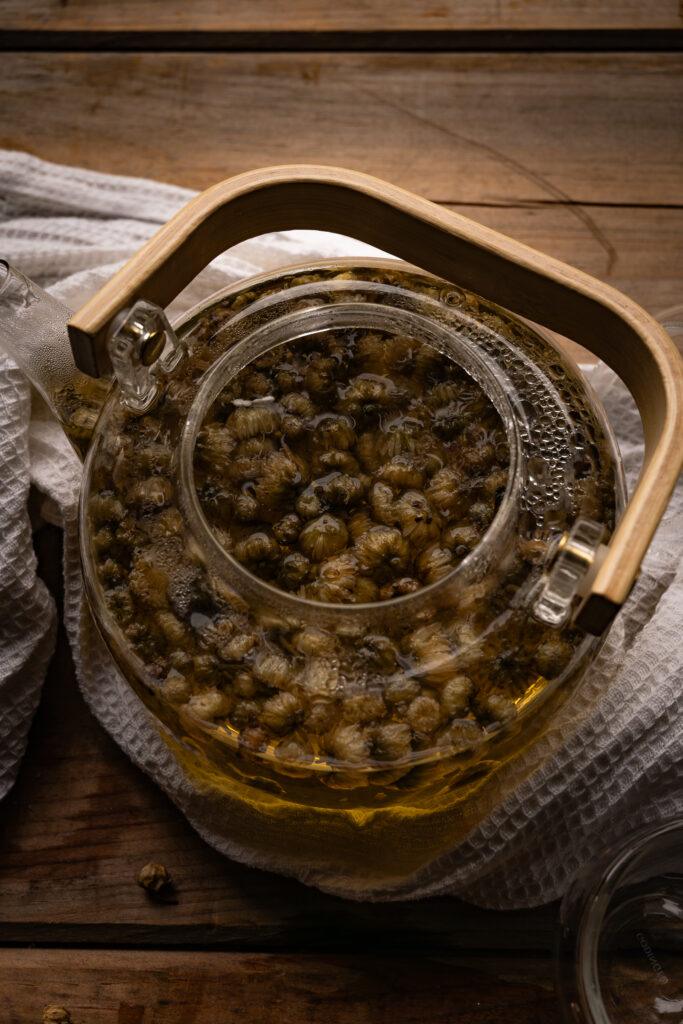
What My Grandmother Told Me About When to Drink It
My grandmother had strong opinions about when chrysanthemum tea was especially good:
Hot weather: “Chrysanthemum tea cooling,” she’d say, making it constantly during summer. Even now, when it’s sweltering outside, I make a pitcher and think of her.
When your eyes are tired: This was her big thing. If I’d been reading or studying too long, she’d make me chrysanthemum tea. “Good for eyes,” she’d insist. “Drink, rest eyes, feel better.” Whether it was the tea or just the break she forced me to take, I always did feel better.
After eating too much: Family gatherings with huge meals always ended with chrysanthemum tea. “Help digestion,” my grandmother would say, serving it to everyone.
Any time you need calm: My grandmother seemed to instinctively know when someone needed calming down. Stressed about school? Chrysanthemum tea. Argument with siblings? Chrysanthemum tea. Just a bad day? Chrysanthemum tea.
I’ve carried these habits into my adult life. Bad day at work? I make chrysanthemum tea. Eyes tired from staring at screens? Chrysanthemum tea. Hot afternoon? You know what I’m drinking.
The Ritual I Inherited
Making chrysanthemum tea now, decades later, I find myself doing everything exactly the way my grandmother did. I rinse the flowers. I count them individually. I let the water cool slightly after boiling. I watch the flowers unfurl and the water turn gold. I add rock sugar and let it dissolve slowly.
These aren’t just steps in a recipe—they’re a connection to her, to my childhood, to something bigger than just making a cup of tea.
There’s something meditative about following the same process she followed, that her grandmother followed. In a world that’s constantly changing, this remains exactly the same. Three ingredients. The same simple method. The same beautiful result.
I’ve taught friends how to make it. I’ve brought dried flowers and rock sugar as gifts. I’ve served it at parties where it’s always the most talked-about beverage. But mostly, I make it for myself, in quiet moments when I need that connection to my childhood and my grandmother.
What It Tastes Like (To Someone Who Grew Up Drinking It)
People always ask me to describe the taste, and it’s hard because it’s so familiar to me. It’s like asking someone to describe what their mother’s cooking tastes like—it just tastes like home.
But I’ll try. It’s floral, but not perfume-y. It’s subtly sweet even without sugar, with a clean, refreshing quality that’s hard to find in other teas. There’s a very gentle bitterness at the end that I actually love—my grandmother always said that slight bitterness was important, that it balanced everything out.
The rock sugar adds just enough sweetness to enhance the natural flavor without making it taste like a dessert drink. It’s sophisticated but simple. Delicate but satisfying.
When I drink it cold, it reminds me of being a kid, coming in from the heat, my grandmother pressing a cold glass into my hands. When I drink it hot, I think of winter afternoons at her house, doing homework at her kitchen table.
The taste is inseparable from the memories for me.
Storing Ingredients the Way My Grandmother Did
Dried flowers: My grandmother kept hers in a large glass jar with a tight-fitting lid, stored in her pantry away from sunlight. They’d last for at least a year this way. I do the same now. Sometimes when I open the jar, the scent takes me right back to her kitchen.
Rock sugar: She kept this in a jar too, right next to the tea flowers. Rock sugar lasts basically forever if kept dry. Mine sits on my counter in a glass jar, just like hers did.
Brewed tea: My grandmother always said to drink it within 3-4 days if you kept it in the refrigerator. After that, the flavor would fade and it wouldn’t taste right anymore. I’ve never tested whether it would last longer—I just follow her rule.
The Variations She’d Make (Still Just Three Ingredients)
My grandmother’s recipe never changed in terms of ingredients—always flowers, water, and rock sugar—but she’d adjust the ratios depending on the situation:
Stronger version: On the hottest summer days, she’d use 10-12 flowers per cup instead of 6-8. “Need strong tea when body too hot,” she’d explain.
Lighter version: Sometimes she’d make a very light version with only 4-5 flowers per cup, usually in the evening. “Too strong before sleep, not good,” she’d say.
Less sweet: As I got older, she started making it with less rock sugar, just one small piece or sometimes none at all. “Let you taste the flower more,” she’d say.
No sugar at all: Occasionally she’d make it completely unsweetened, especially if she was drinking it after dinner. The flowers have enough natural subtle sweetness that it still tasted good.
That’s it. Those were her “variations.” Nothing complicated, no adding other ingredients. Just adjusting the ratios of the same three things.
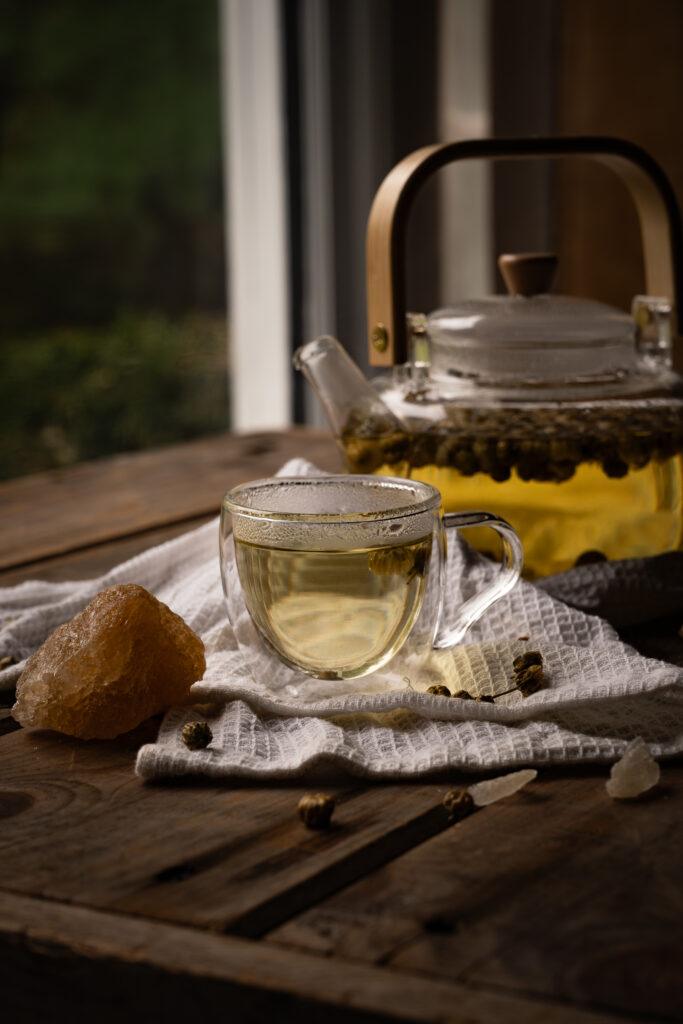
Common Questions I Get (And What My Grandmother Would Say)
“Can I use regular sugar instead of rock sugar?” My grandmother would frown at this question. “Can use, but not same,” she’d say. Rock sugar really does taste different—cleaner, less cloying. But if you can’t find it, she’d grudgingly admit that regular sugar works, you just might need less of it.
“How many times can I reuse the flowers?” My grandmother always reused them! She’d steep the same flowers 2-3 times, just adding more hot water. Each steeping would be lighter in flavor. “First steep strongest, second steep gentle, third steep very soft,” she’d explain. She never wasted anything.
“Can I make it without any sugar?” “Of course!” my grandmother would say. She drank it unsweetened sometimes, especially in the evening. The flowers have their own subtle sweetness.
“Why does mine taste bitter?” My grandmother would immediately ask: “Water too hot? You boil?” If yes, that’s your problem. Let it cool for a minute after boiling. If the water temperature is fine, you might be steeping it too long or using too many flowers.
“Is this healthy?” My grandmother believed chrysanthemum tea was good for cooling the body, helping with eye strain, and aiding digestion. She’d been drinking it her entire life and swore by its benefits. I drink it because I grew up with it and love it, not because I’m trying to cure anything. But there’s definitely something calming and refreshing about it.
Making Larger Batches Like My Grandmother Did
Once a week, usually on weekends, my grandmother would make a huge batch that would last several days. I do the same thing now, and it feels like honoring her tradition.
Her method: Take a large pot or pitcher. Add 50-60 dried chrysanthemum flowers (she’d count them out, every single one). Add 8-10 pieces of rock sugar. Pour hot water to fill the container—usually about 10-12 cups. Steep for 5 minutes, then let it cool completely. Once cooled, refrigerate.
That’s what I do every Sunday evening now. It’s become my weekly ritual, my way of staying connected to her and to my childhood. Every time I make a batch, I think about all the times I watched her do the exact same thing.
Why This Recipe Matters to Me
I’ve learned plenty of recipes over the years—complicated ones with long ingredient lists and multiple techniques. But this three-ingredient chrysanthemum tea from my grandmother is the one I make most often, the one I think about most fondly, the one I’ll probably teach to my own kids someday.
It matters because it’s simple in a world that’s unnecessarily complicated. It matters because every time I make it, I feel connected to my grandmother, to my childhood, to generations of my family who made the exact same tea the exact same way.
Three ingredients. That’s all it’s ever been, all it needs to be.
When I pour hot water over those dried flowers and watch them bloom again, turning the water golden, I’m not just making tea. I’m continuing something my grandmother started, something her grandmother started before her. I’m keeping alive a small tradition that’s been passed down through my family for generations.
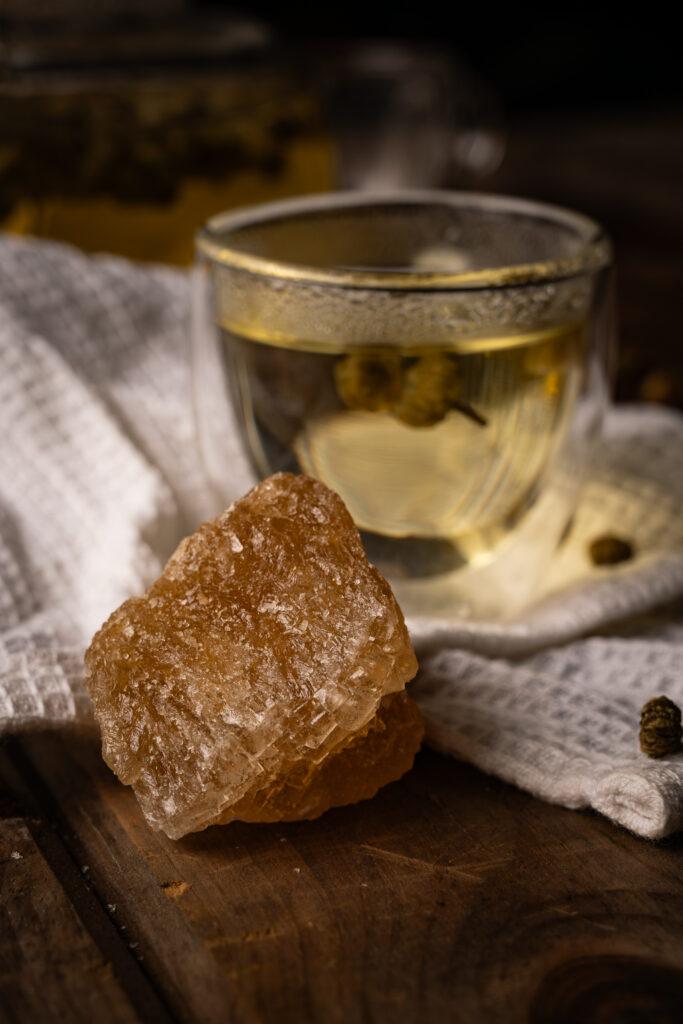
The Bottom Line
If you’ve never tried chrysanthemum tea, I’m giving you my grandmother’s recipe—the one I grew up with, the one I still use today. Get yourself some dried chrysanthemum flowers and rock sugar from an Asian grocery store. Follow the simple steps I’ve outlined above.
The first time you taste it, you might not immediately understand why it’s been such a constant in my life since childhood. It’s subtle, not bold. It’s gentle, not dramatic. But give it time. Make it a few more times. Pay attention to how refreshing it is, how calming, how different from anything else you drink.
Maybe it’ll become part of your routine like it’s been part of mine since I was a kid swinging my legs at my grandmother’s kitchen table.
Three ingredients. Simple method. Generations of tradition. One beautiful cup of tea.
That’s my grandmother’s gift to me, and now I’m sharing it with you.
Happy Sipping,
<3 Ann

